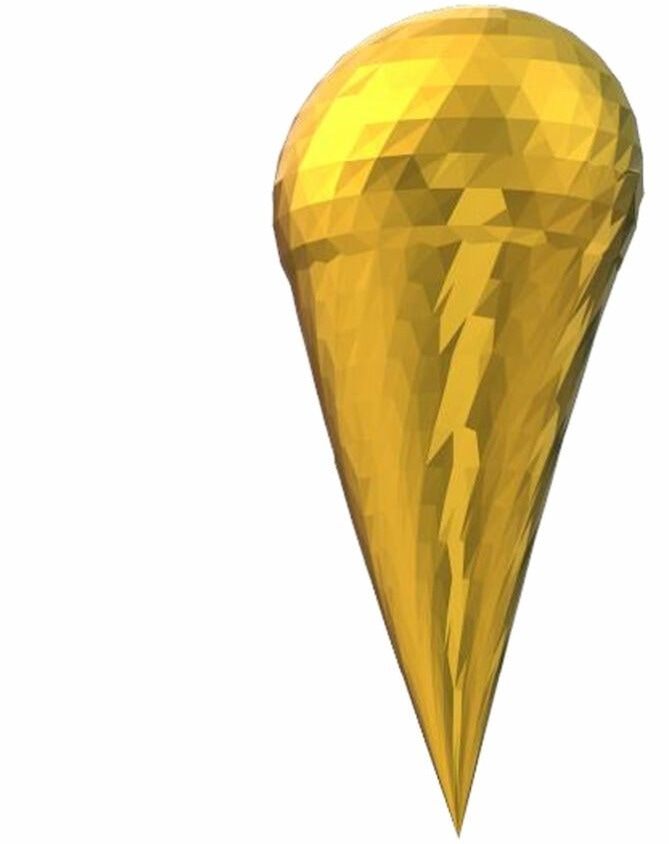According to a recent study done by researchers at the University of Michigan and Jiangnan University in Wuxi, China, teardrop-shaped particles created to inactivate several strains of the SARS-CoV-2 virus might one day complement current COVID-19 treatments.
 This 3D model of a nanoparticle illustrates the left-handed twist that allows them to easily slot into the grooves in the virus spike protein, the part of the virus that recognizes and attaches to human cells. Because of the particle’s left-handed twist, the virus proteins bind more tightly to the particles than human cells. Image Credit: Prashant Kumar, Kotov Lab, University of Michigan
This 3D model of a nanoparticle illustrates the left-handed twist that allows them to easily slot into the grooves in the virus spike protein, the part of the virus that recognizes and attaches to human cells. Because of the particle’s left-handed twist, the virus proteins bind more tightly to the particles than human cells. Image Credit: Prashant Kumar, Kotov Lab, University of Michigan
Although severe cases of the disease have been mostly prevented by the COVID mRNA vaccinations, COVID-19 can still hospitalize vaccinated people, particularly the elderly. Additionally, new strains keep appearing, necessitating ongoing vaccination to keep them effective.
Our immune system has to learn about a virus to generate the antibodies to fight back against infection, but by that time it may be too late for some people.
Nicholas Kotov, Study Co-Corresponding Author and Irving Langmuir Distinguished University Professor, Chemical Sciences and Engineering, University of Michigan
Treatments are critical for patients at risk of severe COVID-19, but there are few choices on the market today. Pfizer’s Paxlovid antiviral pill has become the preferred treatment after receiving emergency use authorization from the Food and Drug Administration, with clinical studies demonstrating an 89% reduction in hospitalization risk.
However, it may only cut the risk by 50%, perhaps as low as 26%, and the pill may not be suitable for people with cardiovascular disease.
The nanoparticles could help vulnerable people during outbreaks of pandemic virus.
Liguang Xu, Study Co-Corresponding Author and Professor, Jiangnan University
The SARS-CoV-2 spike protein, which allows the virus to assault human cells as well as attack the immune system, is made up of building blocks known as amino acids, and the sequence of amino acids varies from strain to strain.
Antibodies usually target a specific amino acid sequence, so these modifications might enable emerging strains to circumvent immunity developed from previous exposure to other SARS-CoV-2 variants or older versions of the mRNA vaccine.
Instead, the team’s nanoparticles target the direction and degree of twist in spike proteins, commonly known as chirality.
The overall structures of coronavirus spike proteins are similar, and the chirality of these spike proteins is the same, so the particles can interact with many coronaviruses.
Chuanlai Xu, Professor, Jiangnan University
The particles were tested on common cold viruses as well as SARS-CoV-2 variants Wuhan-1 and Omicron. They accomplished this by infecting mice with pseudoviruses containing coronavirus spike proteins on their surfaces, with various pseudoviruses representing different strains. When the mice inhaled the particles, the treatment eliminated 95% of the viruses from their lungs, allowing them to resist infection for up to three days.
There are two types of chirality: left- and right-handed. Left-handed twists at the points of the nanoparticles fit well because of the left-handed twists found in coronavirus spike proteins.
André Farias de Moura, Associate Professor of Chemistry at the Federal University of São Carlos in Brazil and a co-author of the study, stated, “The matching left-handed twist makes the virus better at binding with the particles than with animal and human cells. This makes it more likely that the virus will be captured by the particles before it has a chance to infect cells.”
The researchers still do not know how quickly the particles are removed from the body or if they have any harmful side effects in people, but they expect to discover more with future research.
The study also included researchers from the Chinese Academy of Medical Sciences, Peking Union Medical College, and the Brazilian Center for Research in Energy and Materials.
National Natural Science Foundation of China, U.S. National Science Foundation, Brazil’s National Council for Scientific and Technological Development, Coordenacao de Aperfeicoamento de Pessoal de Nivel Superior, Program of Tutorial Education of the Brazilian Ministry of Education and the State of São Paulo Research Foundation. Computational resources were provided by the National Laboratory for Scientific Computing and the Cloud@UFSCar funded the study.
Journal Reference:
Gao, R., et. al. (2024) Tapered chiral nanoparticles as broad-spectrum thermally stable antivirals for SARS-CoV-2 variants. Proceedings of the National Academy of Sciences. doi:10.1073/pnas.2310469121